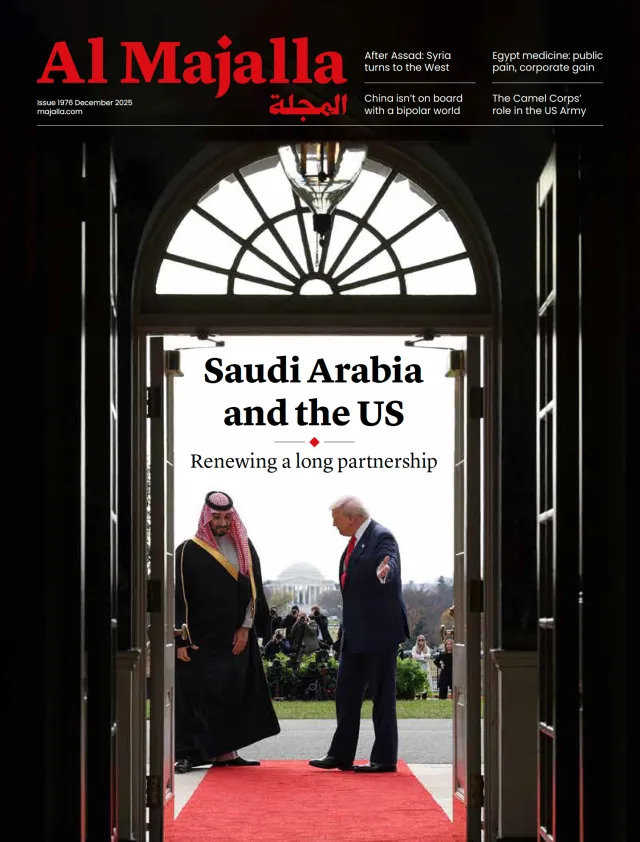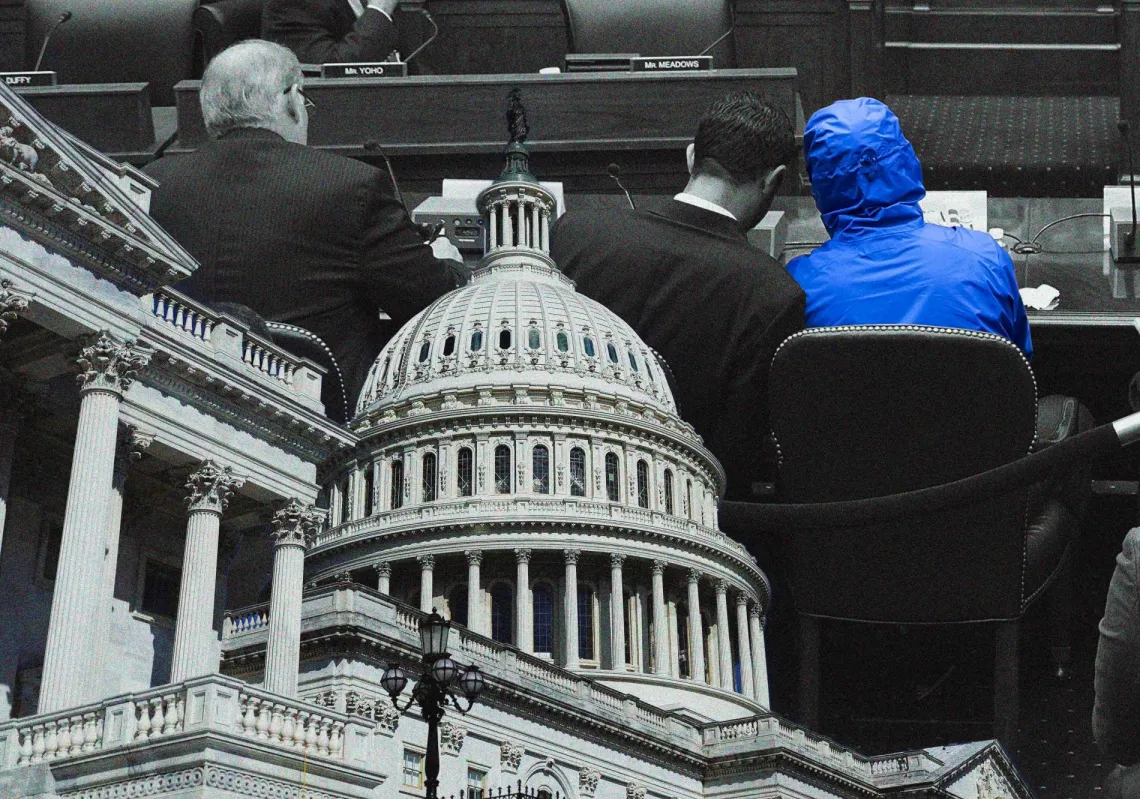Israel finds itself at another critical juncture—one that could dictate both the future of the ceasefire in Gaza and that of the right-wing coalition led by Prime Minister Netanyahu. The answers—both to the question of whether the ceasefire will continue and whether Mr Netanyahu’s government will survive—will come from one man whom the Israeli PM is meeting: US President Donald Trump. Although the Israeli premier is bombastic in public and relatively confident in private, there is a lot at stake, and President Trump is known for being unpredictable.
In that sense, the American President did not disappoint. In typical Trumpian fashion, he brushed aside pesky questions about the future of the ceasefire to focus on a new proposal to have the US “take over” Gaza and “do a job with it too”. The shock announcement is sure to make waves and already has. But before a Trump tower can be built within the new Gaza “Riviera”, there are short-term stumbling blocks that need to be addressed.
Ahead of the visit, Israeli media outlets were concerned with more concrete issues. They reported that the Israeli leader held off a negotiating team that was due to depart on 3 February for negotiations on a “sustainable calm”. This refers to the permanent ceasefire that is due to be announced during the second phase of the current framework (divided into three phases).
The exact content of this “sustainable calm” has not been officially discussed by either side and is due to be negotiated and finalised during phase 1 of the deal—the phase we are currently in. Yet, while, according to the deal, phase 2 negotiations were due to begin on 3 February—a day before Netanyahu was due to meet Trump—the Israeli leader decided to postpone them to consult with the American president first.
Netanyahu knows that with Trump, there is nothing like a face-to-face meeting. The president’s advisors won’t do, and no decision can be taken without some Trump-whispering first. So he is out to meet the man who may as well as be called Israel’s acting PM. And the US president offered a solution Netanyahu himself said in the press conference was going “beyond” his own vision. A vision that put a smile on the Israeli premier’s face, even though it may well never see the light of day.
Between a rock and a hard place
Though Netanyahu has largely welcomed Trump’s election and rides high on the fact that he is the first foreign leader to be invited to meet with the new president, the Israeli leader also knows he faces an impossible situation. His right-wing coalition faces a number of challenges that may lead to its collapse—chief among them the ceasefire itself. The signing of the ceasefire has already led to the departure of far-right leader Itamar Ben Gvir, the former Minister of National Security.
The coalition did not fall then, but it is now more fragile and may suffer yet another defection: That of Netanyahu’s other far-right partner, Bezalel Smotrich. Israel’s current Finance Minister has warned that he would leave the coalition if the war ended without a “total victory”—the kind of victory Netanyahu has promised.
Smotrich also claims that he received guarantees from Netanyahu that fighting would resume at the end of phase 1 of the deal instead of moving to phase 2 when a permanent ceasefire was due to be implemented. If Smotrich were to leave the government, this time, the coalition would lose its majority at the Knesset (the Israeli government) and would thus be at risk of collapsing, explaining why Netanyahu is showering Smotrich with promises and gifts, including a freer hand in the West Bank.
Yet despite those alleged “guarantees” and promises, it is clear that the US administration wants the deal to go through rather than collapse. President Trump wants to present himself as a “peacemaker”, and this image would be swiftly tarnished if the war in Gaza was to resume just a few weeks after it effectively stopped. There is no Gaza Riveria without a permanent ceasefire first. As a result, Netanyahu is caught between a Trumpian rock and a Smotrich-shaped hard place.

Read more: Will Israel’s Netanyahu survive the ceasefire?
Squaring the circle
But this is far from discouraging the Israeli minister, who has been pronounced dead time and time again. Netanyahu wants to explore a number of options that could help salvage his coalition. The fact that Netanyahu was holding off on talks with Hamas until meeting Trump means he wants to understand exactly what President Trump expects of him and what would happen if the talks were to collapse. Whether Netanyahu got clarity on that point is far from certain.
A clearer demand that Israel go through with phase 2 of the deal or not would have dictated Israel’s position in future talks and whether Israel makes a hard bargain or leaves space for compromises on the future of Gaza and the war. For instance, Israel is likely to require that Hamas no longer be the ruling authority in Gaza and even push to have the Hamas leadership exiled from Gaza. If Trump greenlights such a condition, then Smotrich may well come on board, with the expectation that either Hamas will categorically refuse (which is most likely) or that it will be forced to agree, which Smotrich and Netanyahu could indeed paint as a “total victory”.
Another key point is the nature of the future ruling authority in Gaza. Smotrich and Netanyahu have both refused to envision a day after that would allow for a return of Mahmoud Abbas’s Palestinian Authority (PA) to Gaza. The problem is, of course, that there aren’t exactly a myriad of other actors capable of taking over civilian rule in the Palestinian enclave—in fact, the PA itself will require significant outside support to have a realistic shot at remaining in power in Gaza.
Ideally, Netanyahu would want to push the issue of how Gaza is ruled indefinitely, even if that means that Hamas remains the leading power in the Gaza Strip. Netanyahu’s vision is purely security-focused: Israel will retain the ability to strike Hamas if (or more likely as) it regains power. Other actors would have to deal with the responsibility of providing support for the Palestinian population. Of course Netanyahu is offering no clear plan as to the identity of those actors.
Trump’s call to relocate Palestinians
This is where Trump’s recent comments come into play. The President was already shocked when he casually mentioned the need to resettle Palestinians from Gaza to Egypt or Jordan during a briefing on Air Force One. The comments may have seemed “off the cuff”, but they were, in fact, coordinated partly with Israel.
Trump went even further yesterday, on 4 February, when he said the US would "take over" the Gaza Strip and redevelop the Palestinian territory during his news conference with Israeli Prime Minister Benjamin Netanyahu at the White House.
"The US will take over the Gaza Strip, and we will do a good job with it, too," he said. "We'll own it and be responsible for dismantling all of the dangerous unexploded bombs and other weapons on the site," he said. He continued, adding, "Gaza is not a place for people to be living" and that Palestinians living there should “settle permanently” in “a beautiful area” outside of Gaza where they can “be happy”.
Trump said he could even send US troops if needed and that they could stay long-term. He said "the world's people" would be welcome to what could become the "Riviera of the Middle East" but did not mention if any Palestinians would be allowed back.
Egypt and Jordan are staunchly opposed to any such relocation and are unlikely to agree unless forced to do so. The bar is high: If Egypt, for instance, agrees to have a significant number of Palestinians relocate even temporarily in the country, it will certainly face unrest.

Read more: Egypt wants to help shape Gaza's future, but not by taking in Palestinians
Egyptians and Jordanians would see any agreement to have Palestinians relocated to Egypt or Jordan as a de facto support for a new “Nakba”—referring to the expulsion of Palestinians during the 1948 war. Both Egypt and Jordan see this question not as a foreign policy one but as a domestic threat. They know their own regime would be at risk. As a result, the bar is very high for Trump to put enough pressure on Jordan and Egypt to agree.
Are those plans realistic? This may not be important. Pushing for the relocation of Palestinians may be a typical Trumpian bargaining move with an Israeli twist. By waving the threat of potentially forcing Jordan and Egypt to agree to take hundreds of thousands of Palestinian refugees, Trump may be looking to encourage Arab countries to get more involved in plans to stabilise Gaza.
In his speech yesterday, the President appeared to double down with a plan that would directly involve the US. The plan is surprising even when considering Trump’s own propensity to shoot from the hip, as the President has generally sought to disengage from the Middle East rather than the opposite. But the principle remains the same, and by breaking every taboo and offering a vision of what would happen if no alternatives are offered, he seemed to deem others to come up with better plans.
So far, few countries are interested in investing themselves in the “day after”, knowing there’s little benefit in doing so— and significant risks. This means that it has generally been up to Israel and the US, as well as Palestinian factions, to think about a possible “day after”. By waving the threat of relocation and US takeover, Trump is forcing everyone to take notice by waving a scenario where most actors would lose.
The Israeli twist
Of course, there is one type of actor that is wholeheartedly on board with Trump’s plan—namely, the Israeli far-right. Both Smotrich and Ben Gvir have welcomed Trump’s comments, and Smotrich called to implement Trump’s vision, likely hoping that this “temporary resettlement” will, in fact, turn into a permanent one.
After Trump’s Gaza take-over comment, both Ben Gvir and Smotrich praised Trump, with the former posting that this could be the “beginning of a beautiful friendship”.
This is another reason why the comments were, in fact, useful. By raising this prospect, Trump may also buy Netanyahu some goodwill from his far-right partners. There are reasons to think Smotrich, in particular, is in no rush to leave the government. This is first and foremost because his departure could lead to the collapse of the government and to the holding of new elections.
Though Netanyahu is liable to lose, Smotrich may be the even bigger loser, as polls show he may not even get seats at the Knesset. Second, Smotrich has been waiting for Trump to be elected just as much (if not more) than Netanyahu did, in the hope that Trump will side with the Israeli far-right and allow Israel to annex parts, if not all, of the West Bank.
During yesterday's meeting in Washington, Trump said he had not taken a position about Israeli sovereignty over the West Bank and that he would be making an announcement on the issue in the coming weeks.

Leaving government just as Trump begins his term would be seen as a missed opportunity. This latter point is reinforced by Trump’s comments on the relocation of Palestinians, showing that Trump may indeed be the “godsend gift” the far right has been waiting for so long.
If Netanyahu can get Trump to at least tone down some of the most problematic parts of phase 2 of the ceasefire, he may have a chance to convince Smotrich to stay—or at least not to torpedo the government. After Trump’s comments on the “Gaza Riviera”, even Ben Gvir said on Israeli radio that he was more likely to rejoin the Netanyahu government.
This would entail toning down any claim that phase 2 would entail a “permanent ceasefire” (though the cessation of hostility would continue), claiming that Israel reserves the right to resume fighting, avoiding the creation of a new civilian government in Gaza and possibly having Trump continue to push for the relocation of Palestinians and hint that he will consider letting Israel annex the West Bank—something Trump did in his conference, suggesting he was considering the idea.
Creative options
If this does not work, and President Trump cannot be convinced to have Israel resume the war, nor Smotrich convinced to somehow stay as the ceasefire continues, Netanyahu will have to get even more creative. This is made difficult by the fact that he faces additional domestic challenges.
The first is a very controversial draft exemption law that would continue to allow ultra-Orthodox Jews to avoid serving in the military. Opposition to such a law has grown significantly during the war. Essentially, apart from religious parties, who are adamant Netanyahu needs to pass this law, no other parties outright support such a move. Even within the ranks of Netanyahu’s own Likud party, a significant group of members of the Knesset are opposed to a law that would not lead to a significant increase in the recruitment of ultra-Orthodox.
The second difficulty is the need to pass a budget law by the end of March. According to Israeli law, if the government fails to pass a budget law by then, the Knesset will automatically be dissolved, and elections will have to be held.














